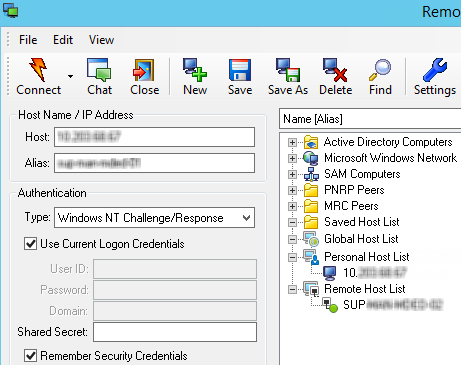What kind of host lists are there in Dameware?
This topic applies to both Remote Support and Mini Remote Control.
A Global Host List enables Dameware technicians to access a common list of hosts internal to their network. A Central Server administrator populates a Global Host List in the Central Server, and this list is displayed when a technician logs in to Dameware Remote Support or Dameware Mini Remote Control in centralized mode. Global Host Lists can only be edited in the Administration Console.
The following graphic illustrates a Global Host List as it is displayed in Dameware Remote Support.

A Remote Host List enables Dameware technicians to access a common list of hosts external to the network.
Remote Host Lists are only available via Dameware Mini Remote Control if you have installed Dameware Remote Support centralized.
Connecting with a remote host through an Internet Session requires that you have:
- Configured a NAT rule that translates a public IP address to your internal network
- Opened ports 80, 443 (use port 444 if port 443 is not available), 6129, 6130, 6132, and 6133
- Configured a port forwarding rule for the port number >> IP address and vice versa (inbound - outbound traffic)
Dameware supports two types of remote host Internet Sessions:
- Attended sessions: A Dameware technician initiates an attended remote session from within Dameware Mini Remote Control on an as-needed basis. The session disconnects when either the technician or the customer ends the session. Use attended sessions when you rarely or will never support the user in the future.
- Unattended sessions: Unattended sessions can be initiated from the list of remote hosts that display in Mini Remote Control. The remote host list is created by a Dameware Central Server Administrator, or a user with administrator privileges, in the Administration Console. The connection with a remote host can be established multiple times. Use unattended sessions when you support an employee that works from home, and outside your company's network.
The following graphic illustrates a Remote Host List as it displays in Dameware Mini Remote Control.

You can also create a Personal Host List in Dameware. It serves as your own host list that follows you to different installations of the Remote Support or Mini Remote Control applications. This feature is available to Dameware Central Server users (version 11.0 and later) with Remote Support or Mini Remote Control running in centralized mode.
Changes you make to your personal host list are saved to the Central Server. Every time you log in to Remote Support or Mini Remote Control running in centralized mode, the application queries the Central Server for your personal host list.
Your personal host list can only contain the following information:
-
host name or address
-
protocol type
-
comments
To save other information, such as credentials or performance settings, you must save the host to the local Saved Host List. This information is then tied to the local computer and is not available in your personal host list on other computers.
